Commuter rail systems around the world
Africa

Currently there are not many examples of commuter rail in Africa. Metrorail operates in the major cities of South Africa, and there are some commuter rail services in Algeria, Botswana, Kenya, Morocco, Egypt and Tunisia. In Algeria, SNTF operates commuter rail lines between the capital Algiers and its southern and eastern suburbs. They also serve to connect Algiers' main universities to each other. The Dar es Salaam commuter rail offers intracity services in Dar es Salaam, Tanzania. In Botswana, the ( Botswana Railways) "BR Express" has a commuter train between Lobatse and Gaborone.
Asia
East Asia
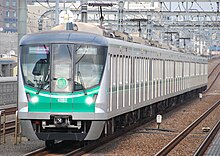
In Japan, commuter rail systems have extensive network and frequent service and are heavily used. In many cases, Japanese commuter rail is operationally more like a typical metro system (with very high operating frequencies, an emphasis on standing passengers, short station spacing) than it is like commuter rail in other countries. Japanese commuter rail also tends to be heavily interlined with subway lines, with commuter rail trains continuing into the subway network, and then out onto different commuter rail systems on the other side of the city. Many Japanese commuter systems operate several levels of express trains to reduce the travel time to distant locations, often using station bypass tracks instead of dedicated express tracks. It is notable that the larger Japanese commuter rail systems are owned and operated by for-profit private railway companies, without public subsidy.
East Japan Railway Company operates a large suburban train network in Tokyo with various lines connecting the suburban areas to the city center. While the Yamanote Line, Keihin Tohoku Line, Chūō–Sōbu Line services arguably are more akin to rapid transit with frequent stops, simple stopping patterns (relative to other JR East lines) no branching services and largely serving the inner suburbs; other services along the Chūō Rapid Line, Sōbu Rapid Line/ Yokosuka Line, Ueno–Tokyo Line, Shōnan–Shinjuku Line etc. are mid-distance services from the outer suburban lines through operating into these lines to form a high frequency corridor though central Tokyo.
- Hanshin Namba Line and Kintetsu Namba Line have a busy east west underground section that allow trains from both Hanshin Electric Railway and Kintetsu Railway to access Namba, a major commercial center of Osaka, and service destinations east and west of Osaka.
Other commuter rail routes in Japan include:
- Osaka Metro Sakaisuji Line is a north south line that allows Hankyu services from the Senri Line, Kyoto Main Line and Arashiyama Line to enter Osaka city center.
- JR West Tozai Line is an underground east west corridor allowing trains from the Kobe Line, Takarazuka Line and Gakkentoshi Line to access Umeda in central Osaka.
- JR West Osaka Loop Line is a mostly elevated loop line that allows for services from the Yamatoji Line, Hanwa Line and Sakurajima Line to loop around central Osaka.
- JR West Kobe Line/ Kyoto Line is a four track corridor allowing Biwako Line, Kosei Line, Takarazuka Line, San'yō Main Line and Akō Line services to service Kyoto, Osaka and Kobe.
- A special private railway Kōbe Rapid Transit Railway owns two underground corridors (a north south and east west line) that allow for Sanyo Electric Railway, Hankyu railway, Hanshin Electric Railway and Kobe Electric Railway services to enter and cross Kobe city center.
- Most of the trains on the Meitetsu network through operate into a high frequency trunk line on the Meitetsu Nagoya Main Line branching out to other lines on the other side of Nagoya.
Commuter rail systems have been inaugurated in several cities in China such as Beijing, Shanghai, Zhengzhou, Wuhan, Changsha and the Pearl River Delta. With plans for large systems in northeastern Zhejiang, Jingjinji, and Yangtze River Delta areas. The level of service varies considerably from line to line ranging high to near high speeds. More developed and established lines such as the Guangshen Railway have more frequent metro-like service. Hong Kong MTR's East Rail Line, West Rail Line and Tung Chung Line serve as commuter rail for the territory’s various new towns but are operated as a metro system.
The two MTR lines which are owned and formerly operated by the Kowloon-Canton Railway Corporation ( East Rail line and Tuen Ma line which is integrated from the former West Rail line and Ma On Shan line in 2021), then the "KCR"), and MTR's own Tung Chung line connect the new towns in New Territories and the city centre Kowloon together with frequent intervals, and some New Territories-bound trains terminate at intermediate stations, providing more frequent services in Kowloon and the towns closer to Kowloon. Most of the sections of these four lines are overground and some sections of the East Rail Line share tracks with intercity trains to mainland China. The three KCR lines are integrated into the MTR network since 2008 and most passengers do not need to exit and re-enter the system through separate fare gates and purchase separate tickets to transfer between such lines and the rest of the network (the exceptions are between the Tuen Ma line's East Tsim Sha Tsui station and the Tsuen Wan line's Tsim Sha Tsui station, and between the East Rail line's Mong Kok East station and the Kwun Tong line's Mong Kok station).
In Taiwan, the Western line in the Taipei- Taoyuan Metropolitan Area, Taichung Metropolitan Area and Tainan- Kaohsiung Metropolitan Area as well as the Neiwan- Liujia line in the Hsinchu Area are considered commuter rail.
Other examples in East Asia include Seoul Metropolitan Subway of which some lines are suburban lines operated by Korail in South Korea. The system has a 7.8-km-long underground core section used by all services.
Southeast Asia

In Indonesia, the KRL Commuterline is the largest commuter rail system in the country, serving the Jakarta metropolitan area. It connects the Jakarta city center with surrounding cities and sub-urbans in Banten and West Java provinces, including Depok, Bogor, Tangerang, Bekasi, Serpong, Rangkasbitung, and Maja. In July 2015, KA Commuter Jabodetabek served more than 850,000 passengers per day, which is almost triple of the 2011 figures, but still less than 3.5% of all Jabodetabek commutes. [1] Other commuter rail systems in Indonesia include the Metro Surabaya Commuter Line, Prambanan Express, KRL Commuterline Yogyakarta–Solo, Kedung Sepur, Greater Bandung Commuter, and Cut Meutia.
In the Philippines, the Philippine National Railways has two commuter rail systems currently operational; the PNR Metro Commuter Line in the Greater Manila Area and the PNR Bicol Commuter in the Bicol Region. A new commuter rail line in Metro Manila, the North–South Commuter Railway, is currently under construction. Its North section is set to be partially opened by 2021.
In Malaysia, there are two commuter services operated by Keretapi Tanah Melayu. They are the KTM Komuter that serves Kuala Lumpur and the surrounding Klang Valley area, and the KTM Komuter Northern Sector that serves Greater Penang, Perak, Kedah and Perlis in the northern region of Peninsular Malaysia.
In Thailand, the Greater Bangkok Commuter rail and the Airport Rail Link serve the Bangkok Metropolitan Region. The SRT Red Lines, a new commuter line in Bangkok, started construction in 2009. It opened in 2021.
Another commuter rail system in Southeast Asia is the Yangon Circular Railway in Myanmar.
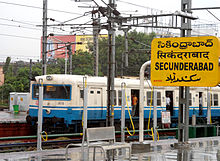
South Asia
In India, commuter rail systems are present in major cities. Mumbai Suburban Railway, the oldest suburban rail system in Asia, carries more than 7.24 million commuters on a daily basis which constitutes more than half of the total daily passenger capacity of the Indian Railways itself. Kolkata Suburban Railway is the biggest Suburban Railway network in India covering 348 stations carries more than 3.5 million commuters per day. The Chennai Suburban Railway along with MRTS is another railway of comparison where more than 2.5 million people travel daily to different areas in Chennai. Other commuter railways in India include Hyderabad MMTS, Delhi Suburban Railway, Pune Suburban Railway and Lucknow-Kanpur Suburban Railway.
In 2020, Government of India approved Bengaluru Commuter Rail to connect Bengaluru and its suburbs. It will be unique and first of its kind in India as it will have metro like facilities and rolling stock.
Karachi in Pakistan has had a circular railway since 1969. Also, in Bangladesh, there are several commuter rail systems.
West Asia
In Iran, SYSTRA proposed 4 express lines similar to RER suburban lines in Paris. Tehran Metro is going to construct express lines. For instance, the Rahyab Behineh, a consultant for Tehran Metro, is studying Tehran Express Line 2. Tehran Metro currently has a commuter line, which is Line 5 between Tehran and Karaj. Isfahan has two lines to its suburbs Baharestan and Fuladshahr under construction, and a third line to Shahinshahr is planned.
In Turkey; Başkentray, İZBAN, and Marmaray are well-known examples.
Europe
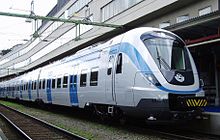
Major metropolitan areas in most European countries are usually served by extensive commuter/suburban rail systems. Well-known examples include BG Voz in Belgrade (Serbia), S-Bahn in Germany, Austria and German-speaking areas of Switzerland, Proastiakos in Greece, RER in France and Belgium, Servizio ferroviario suburbano in Italy, Cercanías and Rodalies ( Catalonia) in Spain, CP Urban Services in Portugal, Esko in Prague and Ostrava (Czech Republic), HÉV in Budapest (Hungary) and DART in Dublin (Ireland).
London has multiple commuter rail routes:
- The Elizabeth line will run on a 22 kilometres (14 mi)-long east–west twin tunnel under central London ( Crossrail project) as its central core section.
- Thameslink brings together several branches from northern and southern suburbs and satellite towns in to a high frequency central tunnel underneath London.
- The London Overground, by contrast, skirts through the inner suburbs with lines mostly independent of each other, although there are several branches. The Watford DC line, partly shared with underground trains, uses third rail, but parallels a main line using overhead wires.
The Merseyrail network in Liverpool consists of two commuter rail routes powered by third rail, both of which branch out at one end. At the other, the Northern Line continues out of the city centre to a mainline rail interchange, while the Wirral Line has a city-centre loop.
Birmingham has four suburban routes, one of which is operated with diesel trains.
The Tyneside Electrics system in Newcastle existed from 1904 to 1967 using DC third rail. British Rail did not have the budget to maintain the ageing electrification system. The Riverside Branch was closed, while the remaining lines were de-electrified. 13 years later, they were re-electrified using DC overhead wires, and now form the Tyne & Wear Metro Yellow Line.
Many of the rail services around Glasgow are branded as Strathclyde Partnership for Transport. The network includes most electrified Scottish rail routes.
The Metro run eleven services which feed into Leeds, connecting the city with commuter areas and neighbouring urban centres in the West Yorkshire Connurbation.
MetroWest is a proposed network in Bristol, northern Somerset & southern Gloucestershire. The four-tracking of the line between Bristol Temple Meads and Bristol Parkway stations will enable local rail services to be separated from long-distance trains.
The Réseau express régional d'Île-de-France (RER) is a commuter rail network in the agglomeration of Paris. In the centre the RER has high freqency underground corridors where several suburban branches feed similar to a rapid transit system.
Commuter rail systems in Germany are called S-Bahn. While in some major cities S-Bahn services run on separate lines exclusively other systems use the existing regional rail tracks.
Randstadspoor is a network of Sprinter train services in and around the city of Utrecht in the Netherlands. For the realisation of this network, new stations were opened. Separate tracks have been built for these trains, so they can call frequently without disturbing high-frequent Intercity services parallel to these routes. [2] Similar systems are planned for The Hague and Rotterdam.
In Sweden, electrified commuter rail systems known as Pendeltåg are present in the cities of Stockholm and Gothenburg. The Stockholm commuter rail system, which began in 1968, shares railway tracks with inter-city trains and freight trains, but for the most part runs on its own dedicated tracks. It is primarily used to transport passengers from nearby towns and other suburban areas into the city centre, not for transportation inside the city centre. The Gothenburg commuter rail system, which began in 1960, is similar to the Stockholm system, but does fully share tracks with long-distance trains.
In Norway, the Oslo commuter rail system mostly shares tracks with more long-distance trains, but also runs on some local railways without other traffic. Services converge on a primary main line between Asker and Lillestrøm. Oslo has the largest commuter rail system in the Nordic countries in terms of line lengths and number of stations. But some lines have travel times (over an hour from Oslo) and frequencies (once per hour) which are more like regional trains. Also Bergen, Stavanger and Trondheim have commuter rail systems. These have only one or two lines each and they share tracks with other trains.
In Finland, the Helsinki commuter rail network runs on dedicated tracks from Helsinki Central railway station to Leppävaara and Kerava. The Ring Rail Line serves Helsinki Airport and northern suburbs of Vantaa and is exclusively used by the commuter rail network. On 15 December 2019 Tampere got its own commuter rail service.
In Spain Cercanías networks exist in Madrid, Bilbao and Málaga. The Rodalies de Catalunya operate in Barcelona. All these systems include underground sections in the city centre.
In Italy there are several commuter rail networks:
- Milan suburban railway service, operated by Trenord and ATM has numerous services funneling into the underground Milan Passante railway.
- Turin metropolitan railway service, operated by Ferrovie Regione Piemonte and GTT with an underground railway line running through the city used by most services.
- Naples Metro Line 2 is an underground corridor where commuter rail services operated by Trenitalia traverse and service the urban center.
- Bari metropolitan railway service
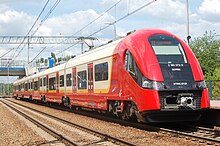
In Poland, commuter rail systems exist in Tricity, Warsaw, Krakow ( SKM) and Katowice ( SKR). There is also a similar system planned in Wrocław and Łódź. The terms used are "Szybka Kolej Miejska" (fast urban rail) and "kolej aglomeracyjna" (agglomeration rail). These systems are:
- Szybka Kolej Miejska w Warszawie in the Warsaw urban area, with 4 lines and 46 stations. [3][ circular reference]
- Łódzka Kolej Aglomeracyjna is located in the center of Poland connecting satellite towns in and around Łódź. It also operates some trains between Łódź and Warsaw.
- Szybka Kolej Miejska w Trójmieście is located in the Tricity/Trójmiasto urban area, the three cities of Gdańsk, Gdynia and Sopot.
The Proastiakos ( Greek: Προαστιακός; "suburban") is Greece's suburban railway (commuter rail) services, which are run by TrainOSE, on infrastructure owned by the Hellenic Railways Organisation (OSE). There are three Proastiakos networks, servicing the country's three largest cities: Athens, Thessaloniki and Patras. In particular, the Athens network is due to undergo modifications to completely separate it from mainline traffic, by rerouting the tracks via a tunnel underneath the city center. A similar project is planned for the Patras network, whereas a new line is due to be constructed for the Thessaloniki network.
In Romania, the first commuter trains were introduced in December 2019. They operate between Bucharest and Funduea or Buftea.
BG Voz is an urban rail system that serves Belgrade. It currently has only two routes, with plans for further expansion. Between early 1990s and mid-2010s, there was another system, known as Beovoz, that was used to provide mass-transit service within the Belgrade metropolitan area, as well as to nearby towns, similarly to RER in Paris. Beovoz had more lines and far more stops than the current system. However, it was abandoned in favor of more accurate BG Voz, mostly due to inefficiency. While current services rely mostly on the existing infrastructure, any further development means furthering capacities (railways expansion and new trains). Plans for further extension of system include another two lines, one of which should reach Belgrade Nikola Tesla Airport.
In Russia, Ukraine and some other countries of the former Soviet Union, electrical multiple unit passenger suburban trains called Elektrichka are widespread. The first such system in Russia is the Oranienbaum Electric Line in St. Petersburg. In Moskow the Beskudnikovskaya railway branch existed between the 1940s and 1980s. The trains that shuttled along it did not go to the main lines, so it was a city transport. Today there are the Moscow Central Circle and the Moscow Central Diameters.
Americas
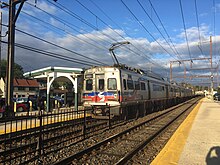
North America
In the United States, Canada, Costa Rica, El Salvador and Mexico regional passenger rail services are provided by governmental or quasi-governmental agencies, with a limited number of metropolitan areas served.


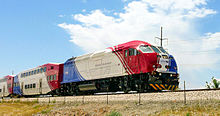
United States
Eight commuter rail systems in the United States carried over ten million trips in 2018, those being in descending order:
- Metropolitan Transportation Authority's Long Island Rail Road, serving New York City and Long Island
- NJ Transit Rail Operations, serving New York City, New Jersey ( Newark, Trenton) and Philadelphia
- Metropolitan Transportation Authority's Metro-North Railroad, serving New York ( Yonkers and New York City) and Southwest Connecticut ( New Haven)
- Metra, serving northeast Illinois ( Chicago), Northern Indiana, and Kenosha, Wisconsin. The network consists of 11 services, of which only the Electric District service runs on tracks exclusively used for passenger traffic.
- SEPTA Regional Rail, serving southeast Pennsylvania ( Philadelphia), as well as Wilmington, Delaware, and Trenton, New Jersey. The network features a tunneled corridor through the city center and through-routed services from several commuter lines. The arrangement of services through the corridor was originally proposed by Vukan Vuchic and Shinya Kikuchi in 1984 and 1985. [4] [5]
- MBTA Commuter Rail, serving Massachusetts ( Boston, Worcester) and Providence, Rhode Island
- Caltrain, serving California ( San Francisco, San Jose, and the San Francisco Peninsula)
- Metrolink, serving California ( Los Angeles, Burbank, Anaheim, San Bernardino, and Southern California)
Other commuter rail systems in the United States (not in ridership order) are:
- Utah Transit Authority FrontRunner, serving Utah ( Wasatch Front)
- North County Transit District Coaster, serving California ( San Diego County)
- Maryland Area Regional Commuter, serving Maryland ( Baltimore) and Washington, D.C.)
- Regional Transportation District, serving Colorado ( Denver)
- Virginia Railway Express, serving suburbs of Northern Virginia and Washington, D.C.
- Sounder commuter rail, serving Washington ( Seattle / Tacoma)
- Tri-Rail, serving Florida ( Miami / Fort Lauderdale / West Palm Beach)
- Trinity Railway Express, serving Texas ( Dallas / Fort Worth)
- Westside Express Service, serving Oregon ( Beaverton / Wilsonville)
- Altamont Corridor Express, serving California ( San Jose / Stockton)
- SunRail, serving Florida ( Orlando/ Poinciana)
- WES Commuter Rail, serving Oregon ( Beaverton/ Willsonville)
- New Mexico Rail Runner Express, serving New Mexico ( Albuquerque)
- Northstar Line, serving Minnesota ( Big Lake and downtown Minneapolis)
- Capital MetroRail, serving Texas ( Austin)
- A-train, serving Texas ( Denton County)
- SMART, serving California ( Sonoma and Marin counties)
- Music City Star, serving Nashville and Lebanon, Tennessee.
- Denver's RTD four electrified commuter rail lines – the A, B, G and N Lines, run on segregated tracks. In its entirety the system combines elements of tram-train and commuter rail.
Canada
- Toronto's GO Transit is in the process of transforming its network to an S-train like system. GO Regional Express Rail (GO RER) will electrify 5 of the 7 core GO lines as well as the Union Pearson Express (UPX). Planned frequencies are all-day, two-way 15 minute or better service in both directions in Toronto and its suburbs. Trains from each line are already through-routed via Union Station. A new fleet of EMUs and electric locomotives will also be procured. The bidder is expected to be announced in 2021. Electrification on the 5 GO Lines is to commence in 2022.
- Exo in Montreal
- West Coast Express in Vancouver
Mexico
- Suburban Railway of the Valley of Mexico Metropolitan Area serving Mexico City
- Toluca–Mexico City commuter rail serving Toluca and Mexico City
Central America
- City Rail serving La Ceiba
- San Salvador Suburban Rail serving San Salvador and Santa Ana
- Rail Transport in Costa Rica serving San Jose
South America
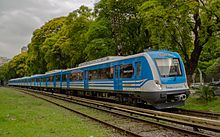
Examples include an 899 km (559 mi) commuter system in the Buenos Aires metropolitan area, the 225 km (140 mi) long Supervia in Rio de Janeiro, the Metrotrén in Santiago, Chile, and the Valparaíso Metro in Valparaíso, Chile.
Another example is Companhia Paulista de Trens Metropolitanos (CPTM) in Greater São Paulo, Brazil. CPTM has 94 stations with seven lines, numbered starting on 7 (the lines 1 to 6 and the line 15 belong to the São Paulo Metro), with a total length of 273 kilometres (170 mi). Trains operates at high frequencies on tracks used exclusively for commuter traffic. In Rio de Janeiro SuperVia provides electrified commuter rail services.
Oceania
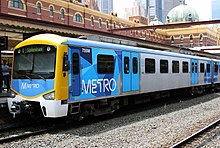
The five major cities in Australia have suburban railway systems in their metropolitan areas. These networks have frequent services, with frequencies varying from every 10 to every 30 minutes on most suburban lines, and up to 3–5 minutes in peak on bundled underground lines in the city centres of Sydney, Brisbane, Perth and Melbourne. The networks in each state developed from mainline railways and have never been completely operationally separate from long distance and freight traffic, unlike metro systems in some comparable countries, but nevertheless have cohesive identities and are the backbones of their respective cities' public transport system. The suburban networks are almost completely electrified.
The main suburban rail networks in Australia are:
- The Sydney Trains suburban rail network consists of nine lines converging in the underground City Circle with frequencies as high as three minutes in this section, 5–10 minutes at most major stations all day and 15 minutes at most minor stations all day.
- The Sydney rail network operated by Sydney Trains in Sydney (with connected suburban services in Newcastle and Wollongong run by its counterpart intercity operator, NSW TrainLink).
- Melbourne's rail network features sixteen electrified commuter rail lines traversing the city centre in the underground City Loop providing a metro-like service in the central core. A second underground core is under construction, as the Metro Tunnel project. V/Line operates some commuter services between Melbourne and surrounding towns, as well as between Melbourne and some locations within the Melbourne metropolitan area.
- Commuter rail services in Brisbane are provided under the Queensland Rail City network brand, featuring twelve electrified lines converging in the city centre. Cross River Rail is an under construction underground cross-city tunnel to relieve pressure on this network.
- Transperth Trains operates commuter rail services in the Perth metropolitan area, with the Joondalup railway line and Mandurah railway line operating at metro-like frequencies.
- The Adelaide rail network operated by Adelaide Metro in Adelaide.
New Zealand has two frequent suburban rail services comparable to those in Australia: the Auckland rail network is operated by Transdev Auckland and the Wellington rail network is operated by Transdev Wellington.
The Auckland Metro network will be converted from a commuter rail system to a S-train system with metro-like frequencies with the completion of the City Rail Link in late 2024. The project will double frequencies to every five minutes at peak and add two underground stations within the Auckland City Centre.
Comparable systems






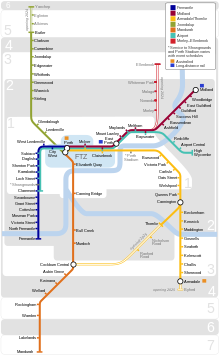

Austria

The oldest and largest S-Bahn system in Austria is the Vienna S-Bahn, which predominantly uses non exclusive rails tracks outside of Vienna. It was established in 1962, although it was usually referred to as Schnellbahn until 2005. The white "S" on a blue circle used as the logo is said to reflect the layout of the central railway line in Vienna. However, it has now been changed for a more stylized version that is used all through Austria, except Salzburg. The rolling stock was blue for a long time, reflecting the logo colour, but red is used uniformly for nearly all local traffic today.
In 2004, the Salzburg S-Bahn went into service as the first Euroregion S-Bahn, crossing the border to the neighbouring towns of Freilassing and Berchtesgaden in Bavaria. The network is served by three corporations: the Berchtesgadener Land Bahn (BLB)(S4), the Austrian Federal Railways (German: Österreichischen Bundesbahn / ÖBB)(S2 and S3) and the Salzburger Lokalbahn (SLB)(S1 and S11) and . The Salzburg S-Bahn logo is only different one, it is a white S on a light blue circle.
In 2006 the regional train line in the Rhine Valley in the state of Vorarlberg has been renamed to S-Bahn Vorarlberg. It is a three lines network, operated by the Montafonerbahn and the ÖBB.
The S-Bahn Steiermark has been inaugurated in December 2007 in Styria, built to connect its capital city Graz with the rest of the metropolitan area, currently the following lines are active: S1, S11, S3, S31, S5, S51, S6, S61, S7, S8 and S9. The network is operated by three railway companies: the Graz-Köflacher Bahn (GKB) (lines: S6, S61 and S7), the ÖBB (lines: S1, S3, S5, S51, S8 and S9) and the Steiermärkische Landesbahnen (StB) (lines: S11 and S31).
In December 2007 as well the Tyrol S-Bahn opened, running from Hall in Tirol in the east to Innsbruck Central Station and Telfs in the west and from Innsbruck to Steinach am Brenner. Class 4024 EMUs are used as rolling stock on this network.
In 2010 the S-Bahn Kärnten was opened in the state of Carinthia and currently consists of 4 lines operated by ÖBB.
The youngest network is the S-Bahn Oberösterreich in the Greater Linz area of the state of Upper Austria, which was inaugurated in December 2016. It is a 5 line system operated by Stern und Hafferl and the ÖBB.
Belgium
The suburban railways of Brussels are currently being integrated into the Brussels Regional Express Network (French: Réseau Express Régional Bruxellois, RER; Dutch: Gewestelijk ExpresNet, GEN), which is identified by the letter S across both languages. [6] In 2018, the S-train was also introduced in Antwerp, Ghent, Liège and Charleroi. [7]
Czech Republic
In the Czech Republic, integrated commuter rail systems exist in Prague [8] and Moravian-Silesian Region. Both systems are called Esko, which is how S letter is usually called in Czech. Esko Prague has been operating since 9 December 2007 as a part of the Prague Integrated Transport system. Esko Moravian-Silesian Region began operating on 14 December 2008 as a part of the ODIS Integrated Transport system serving the Moravian-Silesian Region. Both systems are primarily operated by České dráhy. Several shorter lines are operated by other companies.
Denmark
Copenhagen S-tog connects the city centre, other inner and outer boroughs and suburbs with each other. The average distance between stations is 2.0 km, shorter in the city core and inner boroughs, longer at the end of lines that serve suburbs. Of the 85 stations, 32 are located within the central parts of the city. Weekdays each line have departures every 10th minute with exception for the F-line, which departures every fifth minute. Where several services use the same branches, up to around 30 trains per hour (in each direction) service exists. On Sundays the seven lines are reduced to four lines, but all stations are served at least every 10th minute. The three railway stations at Amager have a local service similar to the S-tog.
The Copenhagen Metro opened in 2002 as a complement to the already existing S-tog system. Copenhagen's S-tog system is the only one in the country. Outside Denmark, in cities where both exist, is it far from unusual that a metro system later has been complemented with a commuter rail system. The branch towards Køge (the southernmost station in the network) has a rather unique history, as it was built in the 1970s where no previous railway ever had existed.
Germany
The trains of the Berlin and Hamburg S-Bahn systems ran on separate tracks from the beginning. When other cities started implementing their systems in the 1960s, they mostly had to use the existing regional rail tracks.
The central intercity stations of Frankfurt, Leipzig, Munich and Stuttgart are terminal stations, so all four cities have monocentric S-Bahn networks. The S-Bahn trains use a tunnel under the central station and the city centre.
The high number of large cities in the Ruhr area promotes a polycentric network connecting all cities and suburbs. The S-Bahn Rhein-Ruhr, as it is called, features few tunnels, and its routes are longer than those of other networks. The Ruhr S-Bahn is the only S-Bahn network to be run by more than one corporation in Germany, and the Salzburg S-Bahn holds a similar distinction in Austria. Most Swiss S-Bahn systems are multi-corporation networks, however.
Most German S-Bahn networks have a unique ticket system, separated from the Deutsche Bahn rates, instead connected to the city ticket system used for U-bahns and local busses. The S-Bahn of Hanover, however, operates under five different rates due to its large expanse.
One S-Bahn system is no longer in operation: the Erfurt S-Bahn which operated from 1976 until 1993 and was an 8.6 km (5.3 mi) single-line system which consisted of four stations from Erfurt Central Station to Erfurt Berliner Straße station in the then newly built northern suburbs of Erfurt.
There are several S-Bahn or S-Bahn-like systems in planning, such as the Danube-Iller S-Bahn and the Augsburg S-Bahn. The S-Bahn system in Lübeck is under discussion.
The Stadtbahn Karlsruhe, a tram-train network, uses the green "S" logo, but does not refer to itself as S-Bahn.
The following networks are currently in operation:
- ^ first electric services started 2019.
Switzerland
S-Bahn is also used in German-speaking Switzerland. While French publications of those networks translate it as RER, the line numbers are still prefixed with an S (e. g. S2).
The oldest network in Switzerland is the Bern S-Bahn, established in stages from 1974 and has adopted the term S-Bahn since 1995. It is also the only one in Switzerland to use a coloured "S" logo. In 1990, the Zürich S-Bahn, which covers the largest area, went into service. S-Bahn services were set up in the course of the Bahn 2000 initiative in Central Switzerland (a collaborative network of S-Bahn Luzern and Stadtbahn Zug), St. Gallen ( S-Bahn St. Gallen) and Ticino ( Rete celere del Canton Ticino).
The Basel trinational S-Bahn services the Basel metropolitan area, thus providing cross-border transportation into both France and Germany. A tunnel connecting Basel's two large intercity stations ( Basel Badischer Bahnhof and Basel SBB) is planned as Herzstück Regio-S-Bahn Basel (lit. heart-piece Regio-S-Bahn Basel).
The RER Vaud of Lausanne and the Léman Express of Geneva serve the area around Lake Geneva (fr. Lac Léman). Transborder networks for the Lake Constance-adjacent German states Baden-Württemberg and Bavaria, the Austrian state Vorarlberg and the Swiss cantons St. Gallen and Thurgau are under discussion. Possible names are Bodensee-S-Bahn and Alpenrhein-Bahn.
References
- ^ "PT KCJ: Keterlambatan KRL Sudah di Bawah 10 Menit". July 6, 2015.
- ^ "Spoorprojecten". Provincie Utrecht. Retrieved 2021-02-09.
- ^ pl:Szybka Kolej Miejska w Warszawie
- ^ Vuchich, Vukan; Kikuchi, Shinya (1984). General Operations Plan for the SEPTA Regional High Speed System. Southeastern Pennsylvania Transportation Authority. pp. 5–2.
- ^ Vukich, Vukan; Kikuchi, Shinya (1985). "Planning an Integrated Regional Rail Network: Philadelphia Case". Transportation Research Record: 52–57.
- ^ Alan Hope (15 September 2015). "NMBS releases details of S-train express network". Flanders Today.
- ^ S-train overview in Belgium (in Dutch)
- ^ "Prague Train Map - Prague, Czech Republic". Expats.cz for Jobs in Prague - Prague Real Estate in the Czech Republic. 2014-07-14. Retrieved 2019-05-01.